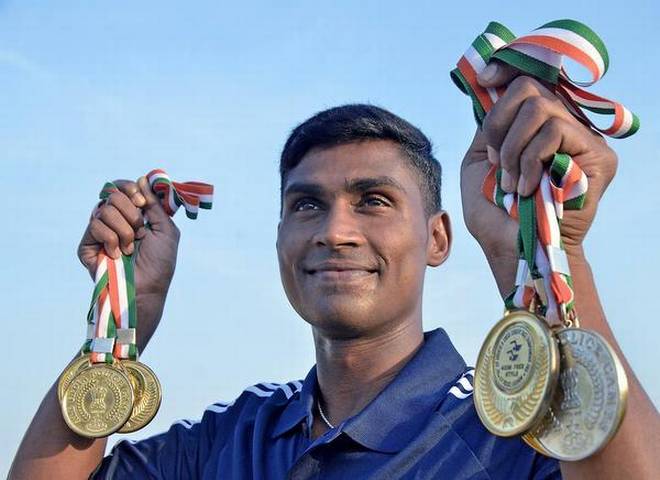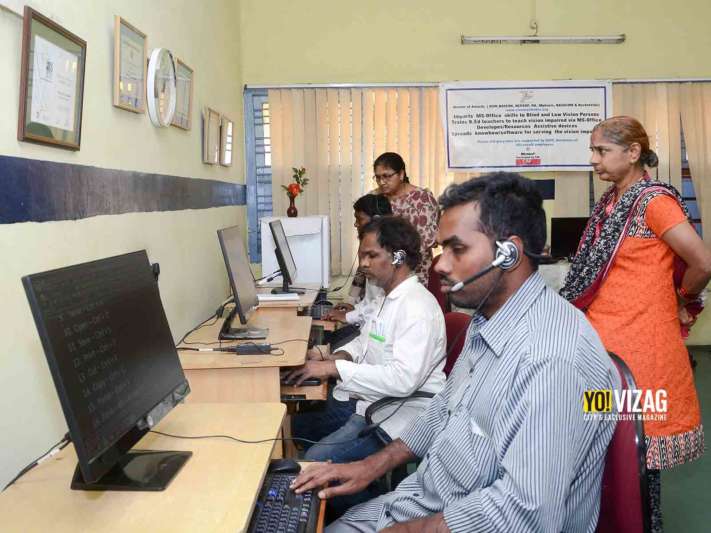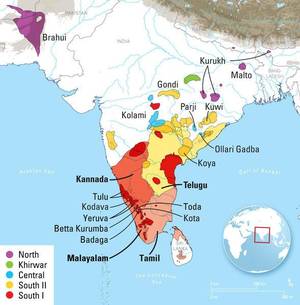Monthly Archives: March 2018
Dravidian language family is 4,500 years old: study
The Dravidian language family’s four largest languages — Kannada, Malayalam, Tamil and Telugu — have literary traditions spanning centuries, of which Tamil reaches back the furthest, resource: .
The Dravidian language family, consisting of 80 varieties spoken by nearly 220 million people across southern and central India, originated about 4,500 years ago, a study has found.
This estimate is based on new linguistic analyses by an international team, including researchers from the Max Planck Institute for the Science of Human History in Germany, and the Wildlife Institute of India in Dehradun.
The researchers used data collected first-hand from native speakers representing all previously reported Dravidian subgroups. The findings, published in the journal Royal Society Open Science, match with earlier linguistic and archaeological studies.
South Asia, reaching from Afghanistan in the west and Bangladesh in the east, is home to at least six hundred languages belonging to six large language families, including Dravidian, Indo-European and Sino-Tibetan.
The Dravidian language family, consisting of about 80 language varieties (both languages and dialects) is today spoken by about 220 million people, mostly in southern and central India, and surrounding countries.
The Dravidian language family’s four largest languages — Kannada, Malayalam, Tamil and Telugu — have literary traditions spanning centuries, of which Tamil reaches back the furthest, researchers said.
Along with Sanskrit, Tamil is one of the world’s classical languages, but unlike Sanskrit, there is continuity between its classical and modern forms documented in inscriptions, poems, and secular and religious texts and songs, they said.
“The study of the Dravidian languages is crucial for understanding prehistory in Eurasia, as they played a significant role in influencing other language groups,” said Annemarie Verkerk of the Max Planck Institute for the Science of Human History.
Neither the geographical origin of the Dravidian language nor its exact dispersal through time is known with certainty.
The consensus of the research community is that the Dravidians are natives of the Indian subcontinent and were present prior to the arrival of the Indo-Aryans (Indo-European speakers) in India around 3,500 years ago.
Researchers said that it is likely that the Dravidian languages were much more widespread to the west in the past than they are today.
In order to examine questions about when and where the Dravidian languages developed, they made a detailed investigation of the historical relationships of 20 Dravidian varieties.
Study author Vishnupriya Kolipakam of the Wildlife Institute of India collected contemporary first-hand data from native speakers of a diverse sample of Dravidian languages, representing all the previously reported subgroups of Dravidian.
The researchers used advanced statistical methods to infer the age and sub-grouping of the Dravidian language family at about 4,000-4,500 years old.
This estimate, while in line with suggestions from previous linguistic studies, is a more robust result because it was found consistently in the majority of the different statistical models of evolution tested in this study.
This age also matches well with inferences from archaeology, which have previously placed the diversification of Dravidian into North, Central, and South branches at exactly this age, coinciding with the beginnings of cultural developments evident in the archaeological record.
source: http://www.thehindu.com / The Hindu / Home> Science / by PTI / Berlin – March 21st, 2018
Now, Sing Thyagaraja Kritis in Malayalam
Retired principal translates 101 compositions of the saint-poet
The Telugu compositions of Sri Thyagaraja have reached God’s Own Country and are available to music connoisseurs in “His own language”.
This was made possible by the efforts of Latha Varma, retired Principal of Madurai-based Sri Sadguru Sangeetha Vidyalayam College of Music and Research Centre. Quite surprisingly, Tamil acted as the bridge in translating the Telugu compositions into Malayalam.
Ms. Varma, who belongs to the royal family of Ernakulam, joined the famed college in Madurai when she was 24 and retired a couple of years ago. As Malayalam is her mother tongue and she gained proficiency in Tamil with her prolonged stay in Madurai, she decided to go the extra mile to learn Telugu literature too. And she did master it with élan through a certificate and diploma course from Madurai Kamaraj University.
Though Thyagaraja kritis are sung world over by people of all languages, many are do not know Telugu and as such miss out on its literary beauty. The mellifluous note and rhythm come in for appreciation, but the ‘Bhava’ (substance) more often than not gets lost. It is this void that the musicologist wanted to fill, at least in Malayalam.
She hand-picked 101 most popular compositions of the saint-poet and gave a word-by-word translation (Prathipadartham) and also a gist (Thathparyam) of each verse. As senior Telugu professor T.S. Giriprakash Rao translated the Telugu verses into Tamil, she picked them up for translation into Malayalam.
An academician, performer cum researcher, Ms. Varma spoke to The Hindu on the sidelines of a seminar on “Group kritis of different vaggeyakaras,”organised by Sri Padmavathi Mahila Viswa Vidyalayam’s (SPMVV) Department of Music and Fine Arts, where she was the key-note speaker.
The translation work, which she calls her “pet project”, lasted for two years. “The copies are now available at the Maharaja’s College for Women and Kerala University, both in Thiruvananthapuram, and the Chittur College in Palakkad. I will soon present some [copies] to the Maharaja’s College in Ernakulam,” Ms. Varma said.
Ms. Varma was felicitated by SPMVV Rector V. Uma, Dean (Social sciences) D.B. Krishnakumari, seminar coordinator K. Saraswathi Vasudev and academic Dwaram Lakshmi on the occasion.
source: http://www.thehindu.com / The Hindu / Home> News> States> Andhra Pradesh / by A.D. Rangarajan / Tirupati – March 21st, 2018
GVMC demolishes encroachments on European cemetery after plaints
Visakhapatnam :
On March 18, while touring the historic Old Town, a group of heritage enthusiasts noticed encroachments upon the 17th century European cemetery grounds near the Kurupam market. A five-storey building has come up in the northern side of the cemetery and a boundary wall has also been constructed.
When brought to the notice of the Greater Visakhapatnam Municipal Corporation authorities, on Monday evening, they demolished the wall.
The encroachment has been estimated to be about 8 feet by 60 feet. One of the gates of the new building also opens onto the cemetery. “We brought it to the notice of the GVMC chief M Harinarayanan, who said he would get it examined by the town planning officers,” said Sohan Hatangadi, one of the organisers of Sunday’s Old Town heritage walk.
Notwithstanding the prompt action by GVMC that helped prevent further encroachment, it is interesting to note that the building was under construction since 2016. The GVMC had then given the permission, but had failed to check whether the structure would encroach upon the cemetery.
source: http://www.timesofindia.indiatimes.com / The Times of India / News> City News> Visakhapatnam News / by Sulogna Mehta / TNN / March 20th, 2018
Vijayawada cop all set to swim across Palk Strait

Tulasi Chaitanya recently swam from Bhimeeli to Vishakhapatnam
City’s head constable Tulasi Chaitanya is all set to swim the Palk Strait (from Sri Lanka’s Talaimannar to India’s Dhanushkodi), covering a distance of 32 kilometres on March 25. He is leaving for Rameswaram on March 17 to train for six days at Dhanushkodi under the watchful eyes of his coach Balaga Ganesh before taking the plunge. “My aim is to cover the distance in nine hours,” said Mr. Chaitanya.
The 30-year-old swimmer said the Palk Strait was at Triveni Sangam where both Arabian Sea and Bay of Bengal entered the Indian Ocean. “The water will be volatile with strong undercurrents and high waves,” said the swimmer, who was groomed under the special attention of Rajiv Trivedi, a top police officer of Telangana cadre.
Mr. Chaitanya, who had already won 14 international medals, will be taking all precautions such as applying of grease on his body to stay away from the jellyfish and sharks. “One pilot boat with GPS system will monitor my stay in the water. Both Sri Lanka and Indian Navy will give protection in their respective borders,” he said. He said he would use freestyle during his pursuit and whenever he needed relaxation he would take up breast and back strokes. “The water temperature will be 28 degree Celsius. Throughout my stay in the water I will be on liquid diet taking lemon water and other health drinks.”
Mr. Chaitanya recently swam a distance of 26 kilometres from Bhimeeli to Vishakhapatnam just to get used the sea and he covered the distance in less than 10 hours.
Next goal
“My next goal is to swim in Zurich Lake in Switzerland and cover a distance of 27 km,” signed off Mr. Chaitanya.
source: http://www.thehindu.com / The Hindu / Home> News> States> Andhra Pradesh / by J. R. Shridharan / Vijayawada – March 17th, 2018
An inspiring story of a charitable service in Visakhapatnam
Close your eyes, use other senses to live life for an hour, and you’ll realize how much we take the gift of sight for granted. While vision impairment often has no cure, the helplessness that comes with it can be tackled. Vision Aid Charitable Services in Visakhapatnam shows the way in the world of darkness.

With low vision or vision impairment often transferred genetically from the first to the third generation, the often untreatable condition hampers life right since childhood. Not only does it bring downgrades at school, it also brings down the person’s confidence. Dr. MS Raju understood the magnitude of this problem as he travelled the world, and compared the support that other nations are able to afford to the vision impaired, vis a vis India. And so, in 2004, at the age of 70 years, he initiated a change that would bring in low-cost assistive technologies for them. Vision Aid was thus established.
He shares that in India many aren’t even aware that vision impairment can be a genetic problem without a cure. With training and technologies being expensive, and Braille being limited in usage, he decided to address the challenges. Computers are universal in usage, he shares, showing us how computer keyboards and dialpads on phones are actually equipped to be tactile sensory, something that many don’t know.
Vision Aid trains students in using them. Not just this, students are taught to hone their other senses so that they can lead a life as independent as possible. Vision Aid is also one of the few in India to offer access technologies and assistive devices at low cost.
In the line of access technologies, the vision impaired are taught computer skills using audio assistance that reduces the margin of error. The low-cost assistive devices include magnifiers, object sensors, speaking calculators and even a camera mouse.
Their innovations have even earned them recognition like the Nasscom finalist award for social innovations in 2011, RA Rockefeller award as best NPO in Southern India in 2010 and NCP Mphasis award in 2009 among others.
Today this NGO encourages those with low vision to join their classes at no fee. In fact, their teaching model allows a student to join at any point in time and for anyone hour slot during the day. They are however required to complete 55 one on one sessions at the center.
For this, the organization also offers escort services.
Removing the obstacles that stand in the way of learning for the vision impaired, English language skills along with computers are imparted as well. Their helpline is open 24/7. With 20-30% of those they train getting jobs, some go for higher education while many benefits from browsing the Internet. From doing menial jobs, opportunities for these students are improving, and this not just enhances their performance but also boosts their confidence.
Along with creating assistive devices, Vision Aid also disseminates know how on handling vision impairment, with the material readily available for all those who wish to use it. Along with empowering students, they also hone teachers as the number of special teachers is still very low in the country.
Sharing that while the eye cannot be repaired, the helplessness of the visually impaired can be, this NGO shines a ray of hope in the world of darkness.
For details contact: Dr.S. Sam Kumar at 9885765115
Website: www.visionaidindia.org
source: http://www.yovizag.com / Yo Vizag / Home> News-City Updates
AU geology prof Jagannadha Rao bags ‘scientist of the year’ award
Visakhapatnam:
M Jagannadha Rao, senior professor of geology and director of Andhra University’s information management centre, has been bestowed with the ‘Scientist of the Year’ award by the National Environmental Science Academy (NESA). The award, for the year 2017, was given to Prof Rao during the NESA’s annual meet in Bhopal recently.
Prof Rao headed the Delta Studies Institute (a petroleum research institute established by the Oil and Natural Gas Corporation in Andhra University) and made significant research related to coastal and deltaic environments of the east coast of India, which has a direct bearing on petroleum exploration. He also conducted refresher courses for ONGC officials on applied coal petrology in oil exploration, and on modern deltas.
source: http://www.timesofindia.indiatimes.com / The Times of India / News> City News> Visakhapatnam News / TNN / March 16th, 2018
11 Andhra girls aim for skies with NASA contest
Visakhapatnam :
Eleven girls from underprivileged families, studying at government-run Kasturba Gandhi Balika Vidyalayas (KGBVs) in Chittoor and Nellore, are on cloud nine after receiving invitations from the National Space Society. (NSS) in the US to participate in the International Space Development Conference (ISDC) that will be held in Los Angeles on May 24.
Prathyusha Velaga, K Reddyrani, Sneha Chetipatti, Divya Gujjala, Roshni Shaik, K Preethi, T Sai Sree, M Pooja, V Saida Bhanu, V Aswani and M Chenchu Lavanya received the invitations on Monday to take part in the annual space contest being organised by NSS in collaboration with the NASA Ames Research Centre.
The girls will present posters on potential human settlements or residential colonies in space and the entries will be sent for judging to NASA. The students will be accompanied to Los Angeles by their teachers and parents and their visits will be sponsored by the state government.
The 11 students are being trained by the state education department and Planetary Society of India (PSI). The proposal to train and equip the girls was put forward by G Srinivas, an IAS officer and state project director of Sarva Shiksha Abhiyan (SSA).
“We launched this project this year and took submissions from the KGBVs of Chittoor and Nellore districts located close to Satish Dhawan Space Centre (SDSC) in Sriharikota. Next year, we plan to take this project forward for all 13 districts in the state. Out of a total of 18 submissions, 11 submissions received invitations from the organisers in US,” Srinivas said.
The grand prize winner will receive the $3,000 NSS Bruce M Clark Jr Space Settlement Award.
source: http://www.timesofindia.indiatimes.com / The Times of India / Home> News> City News> Visakhapatnam News / TNN / March 06th, 2018
